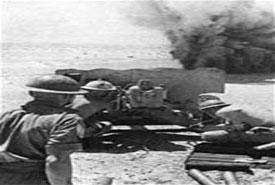
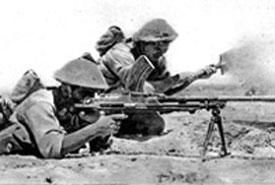
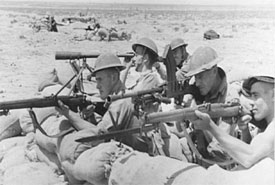
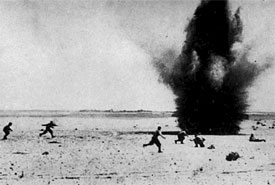
Dust in the wind... Battle of El Alamein
In the burning sands of Africa, far from home many nations united in the fight for freedom, and in November 1942 they started their journey to victory




In 1942 situation in Europe was devastating. Germans were pushing the Russian army back, U-boats were having a major effect on the British in the battle of Atlantic, and the war in Africa started going badly for the British. The Germans needed to give one more blow to the allies, they had to take the Suez. Suez controls the access to the oil rich fields of the Middle East and is an essential point for both the Allies and the Nazi forces. Had the Germans captured the Suez, they would have the oil rich fields of the Middle East, and thus have enough resources for a long, and devastating total war. It was critical that the British do not loose in North Africa, and that they do not leave Suez to the Germans. The Suez would also be a significant psychological blow to the allied soldiers, and especially the British soldiers. El Alamein was the last stand for the Allies in North Africa, located some 150 miles from Cairo, and harboring a very important harbor through which the allies got their supplies. To the north of this city was the Mediterranean sea, and to the south was the Qattara depression. El Alamein was in between a narrow passage, located to the south were mountains which provided a number of easily defensible points and to the north was the Mediterranean. The commander of the German forces was a well respected and one of the most feared generals in the German Army, General Rommel, and the commander of the Allied forces was not so well respected among his troops, general Auchinleck. Auchinleck has already suffered a few defeats after Rommel came with his Afrika Korps to help the Italian army who before he came to Africa suffered a defeat after defeat in Africa. It was even estimated that one German soldier was worth in battle as much as 3 Italian soldiers. Mussolini wanted to control the Mediterranean, and he wanted Africa, but he had a huge obstacle in his way, and that obstacle were the well trained and equipped British troops. Hitler while saying that he'll send Rommel to help Mussolini, and that after that he would leave the territory to Italy, actually had other plans. He wanted to reach the oil rich territories of the Middle East, and the key to controlling the Middle East was North Africa. In fact Hitler never had much trust in his ally, Mussolini, and even said that Italy was always an unstable factor in this war. After Rommel, one of Hitler's most valued Generals was sent to North Africa under excuse that he only wants to help their Italian friends, British forces have suffered several defeats, and the front line during all of war in Africa was constantly moving from east to west, and from west to east. After the Germans came to Africa, it started almost constantly moving to the East, and pushing the Allies out of Africa.
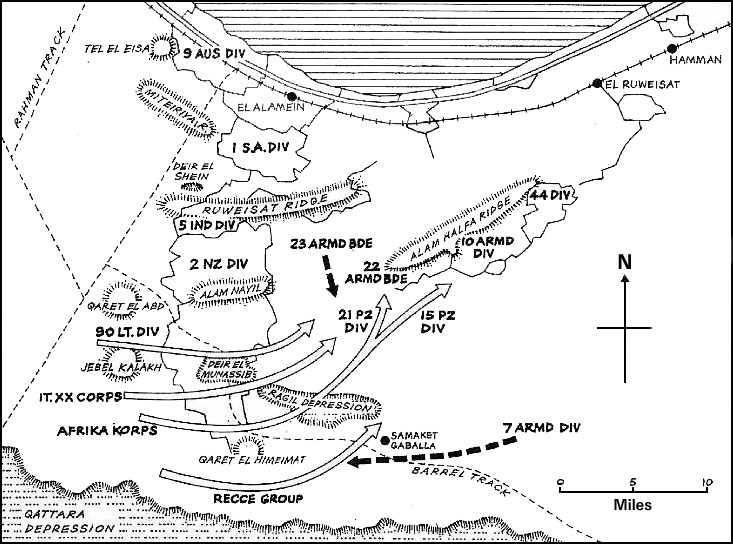
In August 1942, the situation in Africa was desperate. British soldiers were loosing confidence, and morale was running low. Churchill, dismissed Auchinleck and replaced him with Bernard Montgomery. Montgomery though wasn't the first choice of the British prime minister. The general that Churchil wanted in El Alamein suffered an accident just a few days before he was due to arravi and Montgomery was called in as the replacement. Montgomery was well respected among his men, and he worked hard on bringing up the morale, and confidence in the men he commanded. He knew that he had to keep El Alamein at all cost. Because El Alamein was well protected by two mountains from the south, Rommel could not employ his most favored attach, to send troops to attack from behind. The still was a small passage in the south between the two mountains, and Rommel planed to attack from the south. Montgomery had anticipated this, but he was also helped by the British intelligence, which was simply regarded as one of the best in the world at that time, if not the best. They got hold of Rommels plans for the attack on El Alamein, and they found out what are Rommels supply lines. Soon all those information were sent to Montgomery, giving him an advantage. Montgomery was a very cautious general, and he exactly knew what each unit had to do, and paid much attention to organization of any battle. Because Montgomery now knew Rommels supply lines, by August 1942 only 33% of supplies intended for Rommel were getting through to him. Rommel knew that while he had shortages of supplies, the Allies got vast amounts of supplies because they still controlled the Suez, and had a dominant presence in the Mediterranean. This is why Rommel decided to make a quick attack on El Alamein. Montgomery had a great advantage now over his enemy, and knew that Rommel could not sustain a long war, while the Allied forces were ready for their defense at El Alamein by August 1942. Actually when Rommel attacked, Montgomery was woken from his sleep by one of the soldiers to be told the news. Montgomery was so confident that he said, "excellent, excellent", and then went back to sleep. Rommel attacked to the south spearheaded by his tanks at Alam Halfa, but they ran into a mine field, and were stuck there, becoming sitting targets for the Allied fighter planes which easily picked off tank after tank, destroying them one by one. Rommel knew that he had to withdraw, so he ordered his tanks to go north or he would loose all his tanks. When he attacked from the north a sandstorm started, giving his tanks an advantage, providing them with much needed cover from the British defenders. The moment sandstorm was over the well organized defensive forces at El Alamein helped by the Allied bombers started pounding the German panzers. Rommel was defeated and he had to withdraw. Rommel expected to be followed by the British 8th army, but Montgomery refused to do that, preferring to stay secure, and reinforce his defensive positions at El Alamein because he was not ready for an offensive. What Montgomery was waiting for were 300 Sherman tanks, that were recently modified, giving them more combat capability. They were equipped with a 75 mm gun, able to penetrate Nazi tanks at 2000 m distance. In contrast to that Nazi forces had 11000 soldiers, and 500 tanks. Most of these tanks were poor Italian tanks, that were simply no match for the Shermans. Montgomery also had under his command an impressive force of about 200000 soldiers, some of which were excellent Australian and New Zealand troops. Between the Nazi forces, and the Allies was a 5 mile wide mine field equipped with anti-tank, and anti-personnel mines laid by the Germans known as the "Devil's Garden". This proved to be a nightmare for the Allies to cross. Now it was time for Montgomery to launch a counter attack. He tricked Rommel into thinking that the 8th Army would attack him from the south by constructing dummy tanks. Also his 8th army on the north had to disappear so the tanks were camouflaged to look like they were lorries. Rommel was now convinced that the attack would come from the south. Montgomery's attack was codenamed "Operation Lightfoot". The diversion at the south had the intention of taking 50% of Rommel's tanks, while to the north infantry ran over the ant-tank mines as they would not go off if a soldier runs over it, as they are too light to activate the mines. Behind the infantry the engineers worked on clearing the mines. They had the task of clearing several lines that were 24 feet wide, just enough for a tank to go through, but at the end it proved to be a too difficult job for the engineers. The attack on Nazi forces started with about 800 Allied tanks pounding the German positions. As the shells pounded the German lines, the infantry attacked. The engineers set about clearing mines. Their task was very dangerous as one mine was inter-connected with others via wires and if one mines was set off, many others could be. The stretch of cleared land for the tanks proved to be Montgomery’s Achilles heel. Just one non-moving tank could hold up all the tanks that were behind it. The ensuing traffic jams made the tanks easy targets for the German gunners using the feared 88 artillery gun. The plan to get the tanks through in one night failed. The infantry had also not got as far as Montgomery had planned. They had to dig in. The second night of the attack was also unsuccessful. ‘Monty’ blamed his chief of tanks, Lumsden. He was given a simple ultimatum - move forward - or be replaced by someone more energetic. But the rate of attrition of the Allied forces was taking its toll. Operation Lightfoot was called off and Montgomery, not Lumsden, withdrew his tanks.
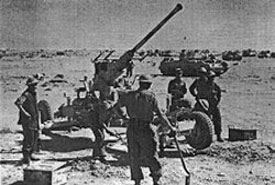
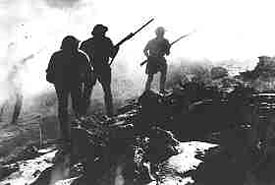
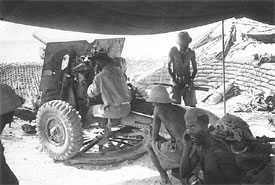
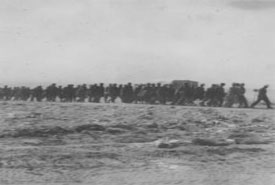
When he received the news, Churchill was furious as he believed that Montgomery was letting victory go. However, Rommel and the Afrika Korps had also been suffering. He only had 300 tanks left to the Allies 900+. ‘Monty’ next planned to make a move to the Mediterranean. Australian units attacked the Germans by the Mediterranean and Rommel had to move his tanks north to cover this. The Australians took many casualties but their attack was to change the course of the battle. Rommel became convinced that the main thrust of Montgomery’s attack would be near the Mediterranean and he moved a large amount of his Afrika Korps there. The Australians fought with ferocity - even Rommel commented on the "rivers of blood" in the region. However, the Australians had given Montgomery room to maneuver. He launched ‘Operation Supercharge’. This was a British and New Zealander infantry attack made south of where the Australians were fighting. Rommel was taken by surprise. 123 tanks of the 9th Armored Brigade attacked the German lines. But a sandstorm once again saved Rommel. Many of the tanks got lost and they were easy for the German 88 gunners to pick off. 75% of the 9th Brigade was lost. But the overwhelming number of Allied tanks meant that more arrived to help out and it was these tanks that tipped the balance. Rommel put tank against tank - but his men were hopelessly outnumbered. By November 2nd 1942, Rommel knew that he was beaten. Hitler ordered the Afrika Korps to fight to the last but Rommel refused to carry out this order. On November 4th, Rommel started his retreat. 25,000 Germans and Italians had been killed or wounded in the battle and 13,000 Allied troops in the Eighth Army.
In the burning sands of the desert, fighting a long way from home young men united in fight for freedom, and made the ultimate sacrifice stepping on a path that lead to the gates of freedom.
Web site made by Igor Radisic from Belgrade, Serbia & Montenegro. E-mail: [email protected]
60 years later... D-day | Bloody city... Stalingrad | Blue grave... Pearl Harbor | A bridge too far... Operation Marketgarden | Horrific thunder... Kursk
© Copyright protected. All rights reserved. Igor Radisic 2004 - 2005